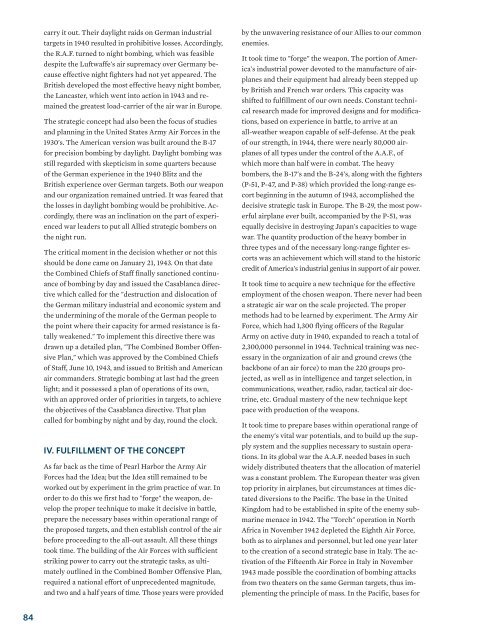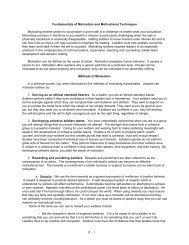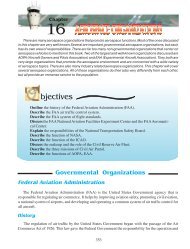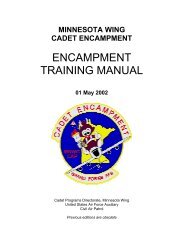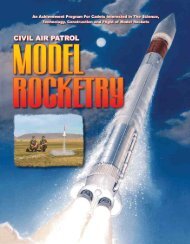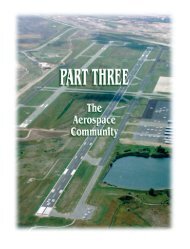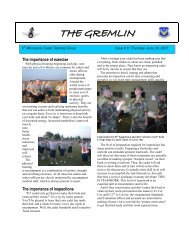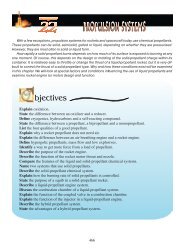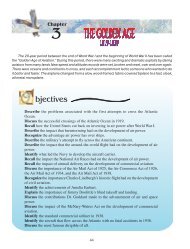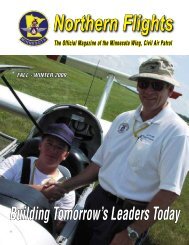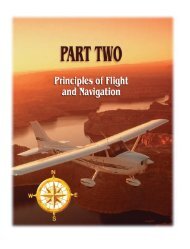carry it out. Their daylight raids on German industrialtargets in 1940 resulted in prohibitive losses. Accordingly,the R.A.F. turned to night bombing, which was feasibledespite the Luftwaffe's air supremacy over Germany becauseeffective night fighters had not yet appeared. TheBritish developed the most effective heavy night bomber,the Lancaster, which went into action in 1943 and remainedthe greatest load-carrier of the air war in Europe.The strategic concept had also been the focus of studiesand planning in the United States Army <strong>Air</strong> Forces in the1930's. The American version was built around the B-17for precision bombing by daylight. Daylight bombing wasstill regarded with skepticism in some quarters becauseof the German experience in the 1940 Blitz and theBritish experience over German targets. Both our weaponand our organization remained untried. It was feared thatthe losses in daylight bombing would be prohibitive. Accordingly,there was an inclination on the part of experiencedwar leaders to put all Allied strategic bombers onthe night run.The critical moment in the decision whether or not thisshould be done came on January 21, 1943. On that datethe Combined Chiefs of Staff finally sanctioned continuanceof bombing by day and issued the Casablanca directivewhich called for the "destruction and dislocation ofthe German military industrial and economic system andthe undermining of the morale of the German people tothe point where their capacity for armed resistance is fatallyweakened." To implement this directive there wasdrawn up a detailed plan, "The Combined Bomber OffensivePlan," which was approved by the Combined Chiefsof Staff, June 10, 1943, and issued to British and Americanair commanders. Strategic bombing at last had the greenlight; and it possessed a plan of operations of its own,with an approved order of priorities in targets, to achievethe objectives of the Casablanca directive. That plancalled for bombing by night and by day, round the clock.IV. FULFILLMENT OF THE CONCEPTAs far back as the time of Pearl Harbor the Army <strong>Air</strong>Forces had the Idea; but the Idea still remained to beworked out by experiment in the grim practice of war. Inorder to do this we first had to "forge" the weapon, developthe proper technique to make it decisive in battle,prepare the necessary bases within operational range ofthe proposed targets, and then establish control of the airbefore proceeding to the all-out assault. All these thingstook time. The building of the <strong>Air</strong> Forces with sufficientstriking power to carry out the strategic tasks, as ultimatelyoutlined in the Combined Bomber Offensive Plan,required a national effort of unprecedented magnitude,and two and a half years of time. Those years were providedby the unwavering resistance of our Allies to our commonenemies.It took time to "forge" the weapon. The portion of America'sindustrial power devoted to the manufacture of airplanesand their equipment had already been stepped upby British and French war orders. This capacity wasshifted to fulfillment of our own needs. Constant technicalresearch made for improved designs and for modifications,based on experience in battle, to arrive at anall-weather weapon capable of self-defense. At the peakof our strength, in 1944, there were nearly 80,000 airplanesof all types under the control of the A.A.F., ofwhich more than half were in combat. The heavybombers, the B-17's and the B-24's, along with the fighters(P-51, P-47, and P-38) which provided the long-range escortbeginning in the autumn of 1943, accomplished thedecisive strategic task in Europe. The B-29, the most powerfulairplane ever built, accompanied by the P-51, wasequally decisive in destroying Japan's capacities to wagewar. The quantity production of the heavy bomber inthree types and of the necessary long-range fighter escortswas an achievement which will stand to the historiccredit of America's industrial genius in support of air power.It took time to acquire a new technique for the effectiveemployment of the chosen weapon. There never had beena strategic air war on the scale projected. The propermethods had to be learned by experiment. The Army <strong>Air</strong>Force, which had 1,300 flying officers of the RegularArmy on active duty in 1940, expanded to reach a total of2,300,000 personnel in 1944. Technical training was necessaryin the organization of air and ground crews (thebackbone of an air force) to man the 220 groups projected,as well as in intelligence and target selection, incommunications, weather, radio, radar, tactical air doctrine,etc. Gradual mastery of the new technique keptpace with production of the weapons.It took time to prepare bases within operational range ofthe enemy's vital war potentials, and to build up the supplysystem and the supplies necessary to sustain operations.In its global war the A.A.F. needed bases in suchwidely distributed theaters that the allocation of materielwas a constant problem. The European theater was giventop priority in airplanes, but circumstances at times dictateddiversions to the Pacific. The base in the UnitedKingdom had to be established in spite of the enemy submarinemenace in 1942. The "Torch" operation in NorthAfrica in November 1942 depleted the Eighth <strong>Air</strong> Force,both as to airplanes and personnel, but led one year laterto the creation of a second strategic base in Italy. The activationof the Fifteenth <strong>Air</strong> Force in Italy in November1943 made possible the coordination of bombing attacksfrom two theaters on the same German targets, thus implementingthe principle of mass. In the Pacific, bases for84
the B-29's were first in China, and later were moved tothe Marianas and Okinawa as the surface attack onJapanese forces closed in on Japan proper. The A.A.F. operationalair bases around the world represented a triumphof American engineering ingenuity, whether by thelaying of huge runways for the super-bombers, or by theconversion of swamps and deserts into air strips bymeans of steel mats.Finally, it took time to gain control of the air, the absolutelynecessary prerequisite for sustained strategicbombing. The German <strong>Air</strong> Force, although designed primarilyto support ground troops, was a formidable defense— a fighting wall in the air. The task was to smashthe wall, not only in order to clear the way for our heavybombers over Germany, but also so as to remove thethreat of air attack on our surface forces during and afterthe planned invasion. The duel with the German <strong>Air</strong>Force ensued.In July 1943 an effort was made to get on with the firstbig task — the destruction of the German fighter system.These battles were a slugging match. A decision mighthave been forced if the Allies had had enough strength tocontinue beyond the one week of concentrated attack.During this period the line of battle was pushed back bywhittling tactics of attrition from mid-Channel to the interiorof Germany. Toward the end of 1943 there was atlast sufficient force in hand. The long-range fightersneeded to combat the enemy fighter defenses had beenperfected, equipped with additional fuel tanks. Otherequipment had likewise been modified under battle conditions.The Strategic <strong>Air</strong> Forces were ready to smash theGerman air wall, and then to proceed with the CombinedBomber Offensive.On February 20, 1944, there began six days of perfectweather which were utilized for a continuous assault onthe widely-dispersed German aircraft-frame factories andassembly plants. This sustained attack, called "The BigWeek," fatally reduced the capabilities of the Luftwaffe.German aircraft production recovered; but the Allies retainedcontrol of the air throughout the remaining 14months of hostilities.In the minds of our air leaders the Big Week was theturning point in the war. That is, the success of the BigWeek confirmed belief in the strategic concept. What hadbeen in doubt was now a certainty. We knew now that wecould destroy the German capacity to make war.Having achieved control of the air, the Strategic <strong>Air</strong>Forces were employed on a twofold mission: 1, preparationfor D-Day by the systematic destruction of theenemy's transport and communications; and 2, progressivedestruction of his synthetic oil plants and other elementsimmediately vital to his continued resistance.On April 16, 1945, the Headquarters of the U. S. Strategic<strong>Air</strong> Forces issued an order ending strategic bombing. Thestrategic air war in Europe was over; the concept hadbeen fulfilled.The lessons learned in the air war over Germany were appliedwith increasing vigor over Japan. The B-29 assaulton the war industries in Japan proper began in the summerof 1944 with small attacks from China; these wereaugmented by attacks of similar weight from the Marianasbeginning in November. The all-out mass offensiveby the Twentieth <strong>Air</strong> Force began with the first low-levelincendiary attack of March 9, 1945, and continued at acceleratedfrequency and intensity until Japan's capitulationon August 14, 1945. An invasion by the surface forceswas not necessary. This air campaign will remain theclassic prototype of the strategic concept as fulfilled inWorld War II.V. APPRAISALSThe United States Strategic Bombing Survey, after nearlya year of study and six months of investigations in Germany,issued the following over-all judgment: "Allied airpower was decisive in the war in Western Europe." Certainauthoritative enemy judgments may be cited in supportof this view.The German reaction was well summed up by LieutenantGeneral Linnarz, Commander of the crack 26th PanzerDivision, when he was interrogated on June 26, 1945, asfollows:The basic conception of winning a war throughstrategic air power is sound. Historically, thestrategic objective of any war has been to destroythe enemy's armies in the field. With increasingtechnological development, however, and the militaryfact that wars are no longer exclusively decidedby generalship and battles, but by a nation'smaterial might and war potential, it is obvious thatin the future the first strategic objective in warcannot be the destruction of the armies in the field,but the destruction of the enemy's resources andwar arsenals. Without these, the armies in the fieldare doomed to eventual defeat. A war might conceivablystart with the attempt to destroy a nation'smaterial power through employing a powerfulweapon of long-range striking power. In this war,such a weapon was the long-range heavy bomber.In the future war it could conceivably be a type ofperfected V-bomb.In my opinion, you might have won the war throughstrategic bombing alone — granted adequate bases, tacticallysecured. Since you wanted to end the war quickly,85
- Page 1 and 2:
VOLUME FOUR STRATEGIC PERSPECTIVESL
- Page 3 and 4:
VOLUME FOUR STRATEGIC PERSPECTIVESL
- Page 5 and 6:
VOLUME FOUR STRATEGIC PERSPECTIVESL
- Page 7:
VOLUME FOUR STRATEGIC PERSPECTIVESL
- Page 10 and 11:
12CHAPTER 12INTRODUCTION TO STRATEG
- Page 12 and 13:
12.1 Strategic Leadership: Defining
- Page 14 and 15:
mandates or resolutions that would
- Page 16 and 17:
and ambiguity, aspiring strategic l
- Page 18 and 19:
12.2 National Security StrategyThe
- Page 20 and 21:
within our borders has always been
- Page 22 and 23:
front common challenges like violen
- Page 24 and 25:
and our strategy, not sector earmar
- Page 26 and 27:
thinking about organizations. She m
- Page 28 and 29:
A systemic approach to failure is m
- Page 30 and 31:
The late W. T. Grant Company is a r
- Page 32 and 33:
the resources - setting the directi
- Page 34 and 35:
focal point for describing and inte
- Page 36 and 37: Consequently, we do not restrict th
- Page 38 and 39: paragraphs, Web pages, then edit an
- Page 40 and 41: Web, can be viewed as a CS attempt
- Page 42 and 43: How to evaluate users and contribut
- Page 44 and 45: 13CHAPTER 13LEADING PUBLIC &VOLUNTE
- Page 46 and 47: 13.1 Leadership for Volunteers:The
- Page 48 and 49: 13.2 Take Root: Volunteer Managemen
- Page 50 and 51: QualificationsClearly list educatio
- Page 52 and 53: and effectively track their volunte
- Page 54 and 55: • Understand rules for recognitio
- Page 56 and 57: • Send a birthday card.• Submit
- Page 58 and 59: and tested more than six decades af
- Page 60 and 61: specific interests of the donors, v
- Page 62 and 63: tain) tax-exempt status from the In
- Page 64 and 65: Smucker, 1999).The Internal Revenue
- Page 66 and 67: culture is necessary to ensure the
- Page 68 and 69: 13.4 The New Look of TransparencyBy
- Page 70 and 71: ees for a couple of reasons: One, i
- Page 72 and 73: 13.5 Public and Private Management:
- Page 74 and 75: TABLE 1:FUNCTIONS OF GENERAL MANAGE
- Page 76 and 77: 3. Career System. The model corpora
- Page 78 and 79: islative charter - the Clean Air Ac
- Page 80 and 81: In controlling performance, Chapin
- Page 82 and 83: 14CHAPTER 14AIRPOWER ASSTRATEGIC LA
- Page 84 and 85: 14.1 Strategic Air Power: Fulfillme
- Page 88 and 89: you did not rely on strategic bombi
- Page 90 and 91: 14.2 Warden and the Air Corps Tacti
- Page 92 and 93: ecomes one of applying sufficient i
- Page 94 and 95: tification, and a Jominian claim to
- Page 96 and 97: courage the rapid and widespread ex
- Page 98 and 99: it to influence physical players in
- Page 100 and 101: 14.4 Basic Air Force DoctrineAF Doc
- Page 102 and 103: earthquake-stricken Haiti. The worl
- Page 104 and 105: perspective. Airmen do not divide u
- Page 106 and 107: Command and ControlCommand and cont
- Page 108 and 109: 14.5 Should the US Maintain the Nuc
- Page 110 and 111: form of human government.” 20 Dem
- Page 112 and 113: obtainable goal. See the Global Zer
- Page 114 and 115: 15CHAPTER 15ORGANIZATIONAL CULTURE
- Page 116 and 117: 15.1 Organizational CultureBy Doria
- Page 118 and 119: Review. This action strives to unco
- Page 120 and 121: gram will serve and then having the
- Page 122 and 123: ticipating the changes being made b
- Page 124 and 125: Many years of working with change p
- Page 126 and 127: At the least, the areas of concern
- Page 128 and 129: 15.4 Developing an Innovative Cultu
- Page 130 and 131: CONCLUDING THOUGHTSIn an ever-chang
- Page 132 and 133: global issues. Businesses that poss
- Page 134 and 135: — Sees the big picture—the shif
- Page 136 and 137:
16CHAPTER 16STRATEGIC COMMUNICATION
- Page 138 and 139:
16.1 Principles of Strategic Commun
- Page 140 and 141:
16.2 The Art of NegotiationBy Brend
- Page 142 and 143:
16.3 Negotiating Effectively Across
- Page 144 and 145:
hidden areas can act as cultural ho
- Page 146 and 147:
and four conflict styles. Hammer be
- Page 148 and 149:
maintaining the relationship. As th
- Page 150 and 151:
25 Mitchell R. Hammer, “Chapter 1
- Page 152 and 153:
tural, socioeconomic, and psycholog
- Page 154 and 155:
for the win-win," during which time
- Page 156 and 157:
interests and, at worst, as a gun s
- Page 158 and 159:
Public diplomacy is surely about mu
- Page 160 and 161:
But public diplomats do not have th
- Page 162 and 163:
Photo courtesy of the familyThe LEA
- Page 164:
THE CADET OATHI pledge that I will


